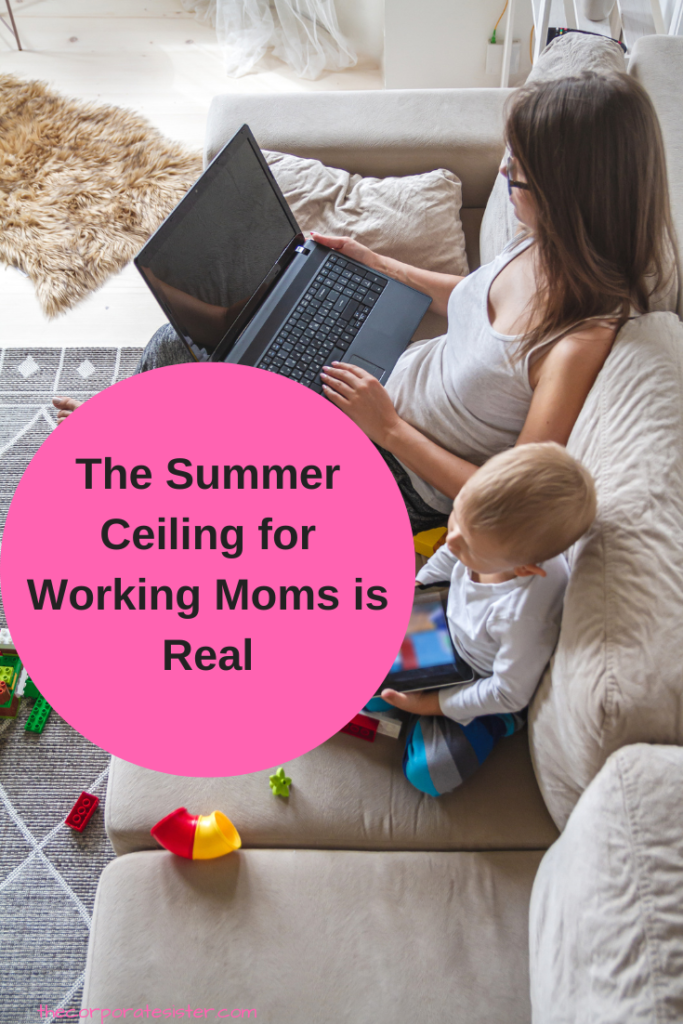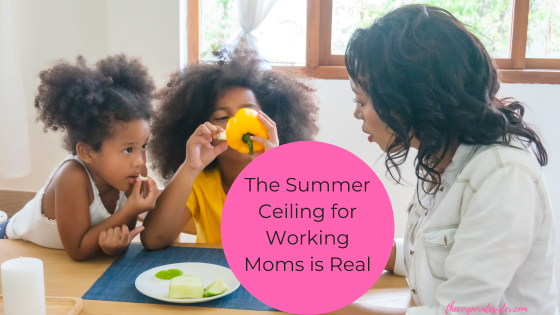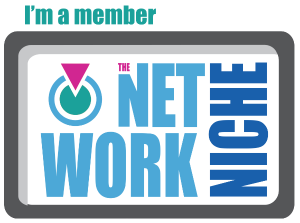Picture it, America, 2023 (in my best Golden Girls’ Sophia Petrillo voice)…
It’s summertime… Just picture the working mom waiting to pick up her kids from camp while mentally reminding herself to mute the impromptu Zoom call’s microphone…Or the working mama cooking dinner while catching up on emails because the day was taken up with monitoring the children’s summer work….Or yet again, the mom with her laptop securely strapped onto the car’s front seat, nervously fingering the mouse pad to signal her presence to an overbearing manager while taking little Pablo to robotics camp…Or better yet, cue the happy families traveling in (apparent) harmony, kids running around through green parks and a general sense of leisurely relaxation floating in the air…Right? Wrong. At least for many working mothers grappling with what I would call the “summer ceiling” for working moms…
“Summer ceiling” = conglomerate of professional and personal obstacles faced by working mothers during the summer months as a result of the scarcity (or complete lack) of childcare resources, couple equity and overall gender equality.
Aka the mother of summer hells, no pun intended… Yet, very few working moms will admit to it. After all, the societal pressure to keep it all together and look like one big happy family while holding our collective coffee-infused breaths, wiping sweaty areas that can’t be publicly revealed, and standing on one half-painted toe, all the while posting heavenly (albeit laborious) Instagram pictures, is still very much prevalent, even in this post-COVID era…
Yet, the reality behind many a glossy vacation picture and outrageously expensive summer camp activity, is that working mothers are facing yet another wall as the summer rolls around. A hot, sweaty, expensive, coordination-filled and energy-draining wall of increased childcare, caregiving and household responsibilities…And may I add, while still desperately attempting to perform at work, never mind advancing projects, boosting careers and keeping some shred of motherly sanity. On the family side of things, many, if not most working moms are alternating finding somewhat reasonably priced summer camps minus the months-long waitlist, with figuring out ways to put grocery shopping on a budget and on auto-dial for permanently hungry and bored kids. Oh, and did I mention the constant agonizing reminder that as working mothers, we only have so many summers left with our kids…No pressure at all…
Related: How to pick the right summer camp for your kids

For many, if not most working moms in the US, summertime brings about a sense of dread and overwhelm at the thought of the accumulation of childcare, caregiving and household labor left vacant by school closures, cost-prohibitive and exclusive summer camps and recreation facilities, and the overall lack of infrastructure to support working parents in general. In the post-COVID era when many working mothers are working from home, many by choice, others by the lack thereof, it also means work will be subject to constant interruptions, unending noise and summer brain fog. Indeed, juggling being a fun yet professional summer mom with a fridge in constant need of refill, overflowing laundry (thank you summer camps) and a generally more chaotic household will create almost unbearable pressure. For those working in the office, it means securing reliable and affordable childcare while dealing with heart-wrenching guilt. In any case, the guilt is always there, as something always gets left to the side, everything seems done halfway, and the pressure keeps building day after day…
Related: Summer Refresh: How to use the warm season to reboot your life and work
Research shows working moms’ work productivity significantly declines during the summer months. Data from the 2022 working paper entitled “The Summer Drop in Female Employment” by Brendan M. Price and Melanie Wasserman documents that summer school closures directly impact women’s employment status. Among women between the ages of 25 and 54, their share of employment as a percentage of the total population drops by an average of 1.1 percentage points. The labor force participation among these women drops by 0.5 percentage points during the summer months. Total hours worked are found to decline by 11% during the same period as well. Working moms were found to spend nearly nine hours more per week than usual on child care during the summer months than during the regular school year, with kids from six to twelve years old presenting the biggest caregiving challenge during that period.
This is not surprising as childcare, caregiving and household care regularly heaped on mothers, are multiplied when school is not in session during the summer months. The resuting decline in work productivity contributes to the slowing down of women’s careers, which are already weakened by the arrival of children and the increase in household and caregiving responsibilities, at least in the US.
Now let’s compare this to Sweden where Swedish parents have a right to 480 days of government-paid leave at a rate of 80% of their earnings for each child born or adopted. This applies to single parents as well, and is directly funded through the Swedish Social Insurance Agency, as opposed to individual employers. In addition, Swedish moms also benefit from an excellent childcare system offering the guarantee of a childcare spot from the first year of age at affordable costs. In general, Swedish working mothers are positively perceived by society and companies alike, allowing them to work on reduced schedules without extensive damage to their career progression. This is in comparison to the United States where employees are only eligible for up to 12 weeks of job-protected yet unpaid leave for illnesses, pregnancy or caregiving of an immediate family member through the 1993 Family and Medical Leave Act (FMLA). However, this is subject to a couple of caveats, including the fact that U.S. employees have to have worked for said employer for at least 12 months or 1,250 hours over the past year, and said employer employs 50 people or more. Additionally, U.S. workers are not necessarily guaranteed their original job upon their return from leave.
This abundance of confounding and frankly sad evidence confirms the summer ceiling hovering just above the heads of countless exhausted (if not burnt out), guilt-ridden, yet still relentlessly determined mothers. It is the summer ceiling so many of us face as the world reminds us how few summers we have left with our kids, while exhorting us to do it all, and do it all perfectly.
The reality is, there is no quick solution, or get-delivered-quick scheme, to the summer ceiling. Like so many other obstacles faced by women and rooted in a combination of social, economic and political factors, it will not be solved through a quick fix. Rather, it is the same combination of political, economic and social factors that created the problem in the first place, that have to be addressed in order to solve it.
Here are some suggestions to do so:
- It’s not you, it’s the system!
Remember the phrase, ”it’s not you, it’s me”? Well, in this case, it’s not you, it’s the system. To be more precise, the patriarchal system designed to nurture privilege and non-inclusive, diverse or equitable access. So the next time you feel inclined to wallow in unending mother’s guilt or give up on your dreams and goals, remember: “It’s not you, it’s the system!”
- Rethink the structure of your work and life
One of the main culprits of couple inequity which contributes to working moms’ exhaustion lies in the very gender inequality fostered in the traditional structure of work and gender roles. Work, as we traditionally know it, was not made for women, and certainly not for mothers. Just compare regular school schedules ending at 2 or 3pm, to the traditional work hours of 9 to 5…Yes, my point exactly…
This is where rethinking the structure of your work and life becomes important. The COVID-19 pandemic forced us to rethink how we work and live, especially as working women and mothers, opening the door to remote working and flexible work arrangements. As a matter of fact, the advent of remote work and its associated flexibility has helped women with childcare needs remain employed. Alternatively, plans to return to the office is spelling trouble for working moms, potentially driving them out of the workforce.
Related: Remote Work and the Working Mom: On Managing your Career Remotely When Life Is Already Full
In the same way, rethinking how we work and live, from considering remote options to adding increased flexibility to our work, can help lessen the impact of the summer ceiling. At the very least, it can start honest conversations in the workplace and at home around setting honest expectations during a period that is so impactful to families, yet can be so challenging and costly to navigate.
- Get engaged!
Last but not least, getting engaged at a level that targets the structural nature of the problem not only can, but is crucial to, change the status quo for working mothers. As mentioned earlier, this is more than just about school closures or the scarcity and cost of summer camps. Certainly, these are important factors that heavily weigh in the balance for working parents in general.
Yet, at the root of these, and so many other similar issues, are structural, institutional and political roadblocks that have been embedded in the fabric of society for a long time. These are the real obstacles to address, the ones that require working women and mothers to get engaged in their communities, at the institutional and political level to contribute to effecting the changes needed. Some of the organizations doing the work to advance the cause of working mothers, include the Chamber of Mothers and Moms First. In addition, getting involved in your local political and social community can contribute to creating change for working moms.
All in all, the summer ceiling is a harsh reality for working mothers during the summer months. Rooted in the scarcity (or lack thereof) of childcare, caregiving and household support, it is a reality that harshly pulls working mothers between family, career and even finances. Yet, it is a reality that also calls us to consider the social, economic and political factors behind it, and take action by removing the guilt, rethinking the structure of our work and lives, and getting engaged.
How are you facing your own summer ceiling? Email us at corporate@thecorporatesister.com to share your story.
The Corporate Sister







